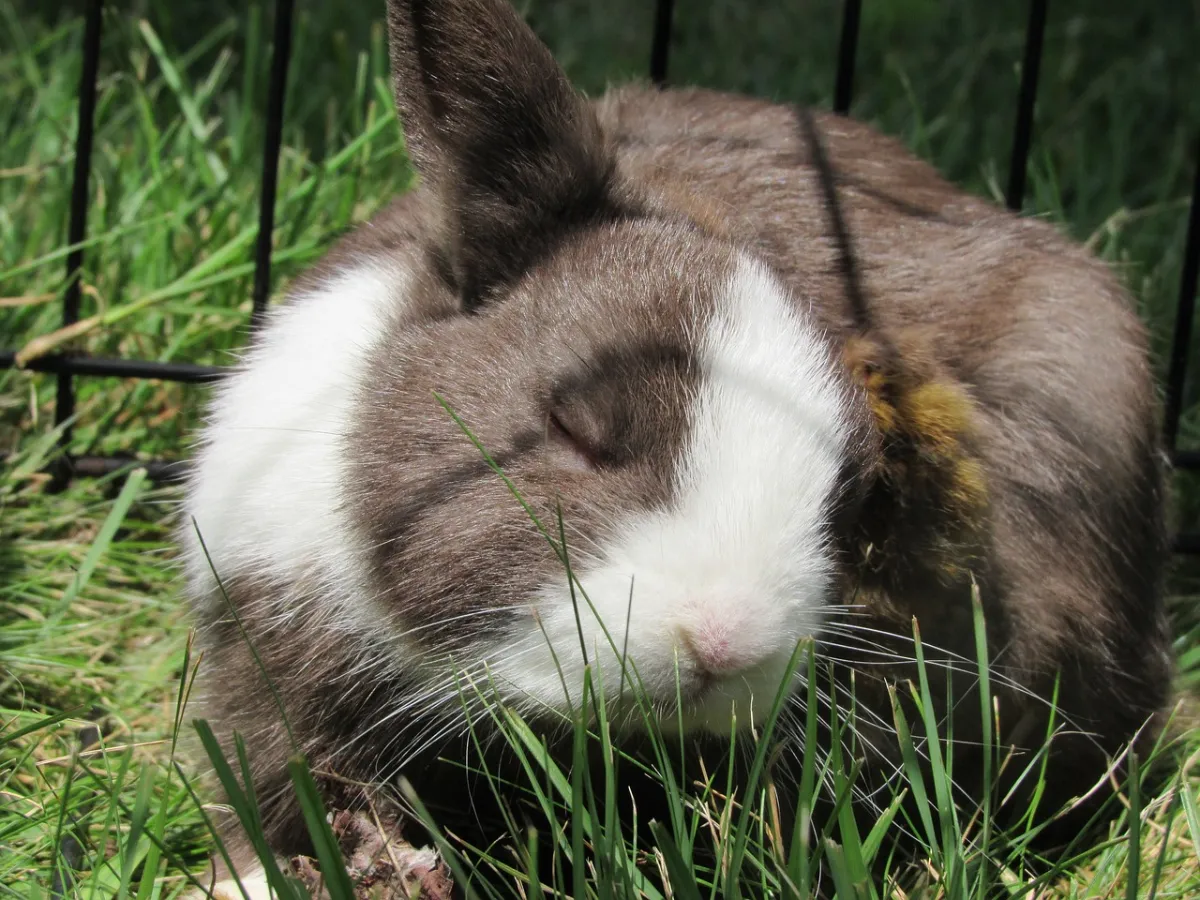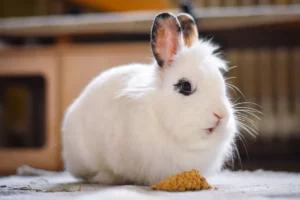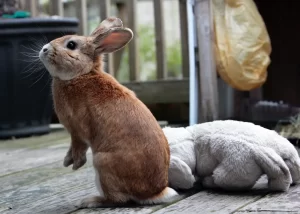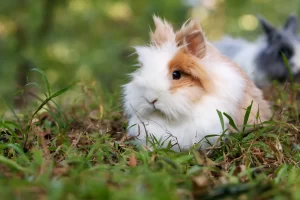Do you ever feel like you’re trying to decode a secret message when you interact with your rabbit? It’s time to unravel the mystery of their behaviors!
In this article, we’ll dive into the captivating world of rabbit body language and uncover the meaning behind 15 of their strangest behaviors. From thumping to hiding, rabbits have a unique way of expressing themselves.
By understanding their body language, you can deepen your bond with your furry friend and give them the love and care they crave. Get ready to be amazed by these jaw-dropping facts about rabbit behavior!
In This Article
- 1 Key Takeaways
- 2 Thumping Behavior
- 3 Chin Rubbing Behavior
- 4 Eating Cecotropes
- 5 Territorial Droppings
- 6 Digging Habits
- 7 Teeth Grinding
- 8 The Zoomies
- 9 Grooming Rituals
- 10 Socialization Cues
- 11 Licking Behavior
- 12 Nose Twitching
- 13 Aggressive Actions
- 14 Litter Box Training
- 15 Thumping and Hiding
- 16 Spraying Behavior
- 17 Frequently Asked Questions
- 17.1 How Can I Prevent My Rabbit From Thumping and Hiding Excessively?
- 17.2 What Are Some Common Reasons for Rabbits to Engage in Aggressive Behaviors?
- 17.3 Is It Normal for Rabbits to Eat Their Cecotropes? Why Do They Do This?
- 17.4 How Can I Effectively Train My Rabbit to Use a Litter Box?
- 17.5 What Are Some Ways to Address Territorial Droppings in Rabbits?
- 18 Conclusion
Key Takeaways
- Thumping is a natural reaction to a threat and warns others to stay away.
- Rabbits eat their cecotropes to obtain necessary nutrients and maintain their health and digestion.
- Rabbits spread their poop to mark their territory and establish ownership.
- Digging is a normal behavior for rabbits and can serve as a form of entertainment or stress relief.
Thumping Behavior
When your rabbit thumps, it’s their way of communicating a warning or signal to others. Thumping is a form of communication that holds great significance in rabbit behavior. It’s a clear indication that your rabbit senses danger or feels threatened.
By thumping their hind legs against the ground, rabbits are able to produce a loud noise that alerts other rabbits to potential threats in the environment. This behavior serves as a warning to the rest of the group to stay away and be cautious.
Thumping can also be a sign of annoyance or uneasiness, indicating that your rabbit isn’t comfortable with a certain situation. Understanding the significance of thumping in rabbit behavior can help you provide a safe and secure environment for your furry friend.
Chin Rubbing Behavior
If your rabbit is chin rubbing, it’s a behavior that serves multiple purposes and can provide valuable insight into their communication and territorial marking. Chin rubbing is a natural behavior for rabbits, and it offers several benefits for their health and wellbeing. By understanding the different types of chin rubbing behavior, you can better understand your rabbit’s needs and emotions.
Here are some key points to consider:
- Chin rubbing helps rabbits mark their territory and establish ownership.
- It leaves behind a specific scent for other rabbits to smell, creating a sense of familiarity and security.
- Chinning objects or even their owners helps rabbits navigate and remember their surroundings.
- Chin rubbing can be a sign of contentment and relaxation in rabbits.
- It can also indicate a need for attention or social interaction.
Eating Cecotropes
Rabbits eat their cecotropes to obtain necessary nutrients and maintain their health and digestion. Cecotropes are a special type of dropping produced by rabbits that are rich in vitamins, minerals, and beneficial bacteria. When rabbits consume cecotropes, they’re able to extract even more nutrients from their food, ensuring optimal health and digestion.
Cecotrope consumption is a normal behavior for rabbits and is essential for their well-being. By consuming their cecotropes, rabbits are able to efficiently absorb nutrients that may have been missed during the initial digestion process. This helps to support their immune system, maintain a healthy gut microbiome, and prevent nutrient deficiencies.
Territorial Droppings
As a rabbit owner, you may notice that your furry friend leaves scattered droppings around their territory. These territorial droppings serve an important purpose in rabbit communication and behavior.
Here’s what you need to know:
- Territorial marking: Rabbits spread their poop to mark their territory and establish ownership. It’s their way of saying, ‘This is mine!’
- Importance of scent: The droppings leave behind a specific scent that other rabbits can smell. This helps them navigate and remember their surroundings, as well as communicate with other rabbits in the area.
Understanding the significance of territorial droppings can help you better understand your rabbit’s behavior and needs. By providing them with a safe and secure environment, you can help them feel more at home and reduce stress.
Digging Habits
To understand your rabbit’s digging habits, observe how they use this behavior for various purposes. Digging is a normal behavior for rabbits and serves multiple functions. One of the primary reasons rabbits dig is for burrow construction. In the wild, rabbits create elaborate underground tunnels for safety and comfort. By observing your rabbit’s digging habits, you can gain insight into their natural instincts.
Additionally, digging can also be a way for rabbits to manage the length of their nails. As rabbits dig, they naturally wear down their nails, preventing them from becoming overgrown. This behavior is essential for the rabbit’s nail maintenance and overall health.
Providing your rabbit with appropriate digging opportunities, such as a digging box filled with safe materials, can help satisfy their natural instincts and promote their well-being.
Teeth Grinding
When your rabbit is content and enjoying itself, you may notice teeth grinding as a sign of relaxation. Teeth grinding, also known as bruxism, is a common behavior in rabbits that serves multiple purposes. Understanding the different types of teeth grinding in rabbits can help you better understand your furry friend’s needs.
Here are some key points to know about teeth grinding in rabbits:
- Relationship between teeth grinding and dental health: Teeth grinding helps rabbits maintain proper dental hygiene by wearing down their teeth and preventing overgrowth.
- Types of teeth grinding: Soft and quiet grinding is a sign of contentment, while loud and frequent grinding may indicate discomfort or pain. It’s important to monitor your rabbit’s teeth grinding to ensure their well-being.
- Dental care for rabbits: Regular veterinary check-ups and a proper diet consisting of hay, fresh vegetables, and limited pellets can help prevent dental issues in rabbits.
- Signs of dental problems: If your rabbit’s teeth grinding is accompanied by drooling, reduced appetite, weight loss, or difficulty eating, it may be a sign of dental problems. Consult a veterinarian for proper diagnosis and treatment.
- Providing appropriate chew toys: Offering your rabbit safe chew toys, such as wooden blocks or apple branches, can help satisfy their natural chewing instincts and promote dental health.
The Zoomies
If you’ve ever seen your rabbit suddenly start sprinting around at top speed, you’ve witnessed one of the most entertaining behaviors known as the zoomies.
These playful antics are a common sight among rabbits and often occur during playtime or when they’re feeling particularly energetic.
The zoomies can be triggered by various factors, such as a change in environment, the presence of other rabbits or animals, or simply being in a joyful mood.
During the zoomies, rabbits may dart back and forth, jump, and twist in the air, displaying their agility and enthusiasm.
It’s important to provide a safe and spacious area for your rabbit to engage in these zoomie sessions, allowing them to express their natural behavior and have a blast.
Grooming Rituals
Rabbits groom themselves regularly to keep their fur clean and free from tangles. Grooming is an essential part of their daily routine and serves several purposes.
Here are some rabbit grooming techniques that you should be familiar with:
- Licking: Rabbits use their tongues to clean their fur, similar to how a cat grooms itself. This helps remove dirt, debris, and loose fur from their coats.
- Nose grooming: Rabbits have a unique behavior called ‘whisker washing,’ where they use their paws to clean their facial whiskers. This ensures that their sensitive whiskers remain clean and functional.
- Ear grooming: Rabbits have long ears that can accumulate dirt and wax. They use their paws to clean their ears and keep them free from debris.
- Self-grooming rituals: Rabbits can often be seen contorting their bodies and stretching to reach all areas of their fur. This helps them groom hard-to-reach places and maintain their overall cleanliness.
- Mutual grooming: Rabbits are social animals and engage in mutual grooming as a bonding behavior. They’ll groom each other as a sign of affection and to reinforce their social hierarchy.
While grooming is a natural behavior for rabbits, there can be some common grooming problems to watch out for. These include fur mites, fur blockages, and overgrown nails. Regularly checking your rabbit’s fur and nails, and seeking veterinary care when necessary, can help prevent and address these grooming issues.
Socialization Cues
To better understand your rabbit’s socialization cues, observe their interactions with other rabbits and humans. Playtime activities are an important aspect of socialization for rabbits. They enjoy hopping, running, and exploring their surroundings.
During playtime, rabbits may exhibit bonding behaviors such as grooming each other or cuddling together. These activities help strengthen their bond and establish trust.
Pay attention to how your rabbit interacts with other rabbits and humans. Do they approach with curiosity and friendliness? Do they show signs of fear or aggression?
Understanding their socialization cues will help you create a positive and enriching environment for your rabbit. Remember, rabbits are social animals and thrive on companionship, so providing opportunities for social interaction is crucial for their well-being.
Licking Behavior
When rabbits lick, they’re often showing affection or marking their territory. Licking behavior in rabbits can have different meanings, and it’s important to understand what your pet is trying to communicate.
Here are a few reasons why rabbits lick:
- Affection: Licking is a way for rabbits to show love and affection towards their owners or other rabbits. It’s their way of bonding and expressing their feelings.
- Grooming: Rabbits are meticulous groomers, and they may lick themselves or their owners to keep their fur clean and free from tangles.
- Marking territory: Licking can also serve as a way for rabbits to mark their territory. By licking objects or even people, rabbits leave behind their scent, indicating ownership.
Understanding your rabbit’s licking behavior can help strengthen your bond and ensure their needs are met.
Nose Twitching
You may notice that nose twitching in rabbits is a fascinating behavior that conveys curiosity and alertness. This behavior is closely related to the sniffing behavior in rabbits, as they use their twitching noses to gather information about their environment.
By twitching their noses, rabbits are able to enhance their sense of smell, which is crucial for their survival in the wild. The significance of nose twitches in rabbit communication is that it helps them to detect potential threats and identify potential food sources.
It also allows them to communicate with other rabbits, indicating their level of curiosity or alertness.
Aggressive Actions
If your rabbit exhibits aggressive behaviors, such as biting or asserting dominance, it’s important to understand their motivations and address any underlying issues. Aggressive behavior in rabbits can be a sign of various emotions or needs. Here are some key points to consider when interpreting growling and other aggressive actions:
- Fear or Threat: Aggression may stem from a rabbit feeling scared or threatened. Identifying and addressing the source of fear can help alleviate aggressive behavior.
- Lack of Socialization: Rabbits that haven’t been properly socialized may display aggression towards humans or other animals. Providing opportunities for positive interactions and socialization can help reduce aggression.
- Hormonal Changes: Unneutered or unspayed rabbits may exhibit aggressive behaviors during mating season or when their hormones are heightened. Spaying or neutering can help regulate hormone levels and reduce aggression.
- Resource Guarding: Rabbits may become aggressive when protecting their food, toys, or territory. Ensuring that rabbits have ample resources and providing them with a safe and secure environment can help minimize resource guarding behaviors.
- Pain or Discomfort: Aggressive behavior can also be a response to pain or discomfort. If your rabbit suddenly displays aggression, it’s essential to consult with a veterinarian to rule out any underlying health issues.
Litter Box Training
To successfully litter box train your rabbit, place the litter box in a convenient and accessible location. This will make it easier for your rabbit to find and use the litter box consistently.
When litter box training your rabbit, there are some common challenges that you may encounter. One challenge is that rabbits may not immediately understand that the litter box is where they should eliminate. They may also have accidents outside of the litter box initially. However, with patience and consistency, these challenges can be overcome.
Here are some tips for successful litter box training:
- Use a litter box with low sides to make it easy for your rabbit to hop in and out.
- Fill the litter box with a suitable litter, such as paper-based or wood pellet litter. Avoid using clumping clay litter as it can be harmful if ingested.
- lace some of your rabbit’s droppings in the litter box to help them recognize it as a bathroom area.
- Reward your rabbit with treats and praise when they use the litter box correctly. This positive reinforcement will encourage them to continue using it.
Remember to be patient and consistent with your training efforts, and soon your rabbit will be using the litter box reliably.
Thumping and Hiding
Thumping and hiding are instinctive behaviors that rabbits use to protect themselves from potential dangers. Understanding rabbit fear responses can help create a safe and secure environment for them.
Here are some key points to consider:
- Thumping: When a rabbit thumps its hind legs, it’s warning others to stay away. This behavior can indicate annoyance or uneasiness. Thumping can also be used to warn intruders of potential danger.
- Hiding: Rabbits have a natural instinct to hide when they sense danger. Providing hiding spots, such as tunnels or boxes, can help rabbits feel safe and reduce stress.
- Quiet environment: Creating a calm and quiet living space can help rabbits feel secure and minimize their fear responses.
- Consistent routine: Establishing a consistent daily routine can help rabbits feel more secure and reduce their anxiety.
- Positive reinforcement: Rewarding rabbits with treats or praise when they display calm behavior can help reinforce a sense of safety.
Spraying Behavior
When it comes to understanding your rabbit’s behaviors, it’s important to be aware of their spraying behavior. Rabbit spraying refers to the act of rabbits marking their territory by urinating on objects or even people. This behavior is a natural instinct for rabbits and serves as a way for them to establish ownership and communicate with other rabbits.
However, it can have certain impacts on both rabbit health and the environment. Rabbit spraying can emit a stronger odor than usual urination and may cause discomfort to those who come into contact with it. To prevent spraying, it’s recommended to have your rabbit spayed or neutered, as this can significantly reduce the likelihood of spraying behavior.
Additionally, providing appropriate litter boxes and regularly cleaning them can also help discourage spraying. By understanding and addressing rabbit spraying, you can create a healthier and more comfortable environment for both you and your furry friend.
Frequently Asked Questions
How Can I Prevent My Rabbit From Thumping and Hiding Excessively?
To prevent your rabbit from excessive thumping and hiding, it’s important to understand rabbit body language. Ensure their environment is safe and provide hiding spots. Address any potential stressors and provide plenty of mental and physical stimulation.
What Are Some Common Reasons for Rabbits to Engage in Aggressive Behaviors?
Common reasons for rabbits to engage in aggressive behaviors include seeking attention, asserting dominance, protecting themselves or their food. To handle aggression in rabbits, provide a safe and stress-free environment, establish boundaries, and consult a veterinarian or animal behaviorist for guidance.
Is It Normal for Rabbits to Eat Their Cecotropes? Why Do They Do This?
Yes, it is normal for rabbits to eat their cecotropes. They do this to obtain necessary nutrients and aid in their digestion. Cecotropes play a vital role in a rabbit’s digestive system.
How Can I Effectively Train My Rabbit to Use a Litter Box?
To effectively train your rabbit to use a litter box, start by placing it in a convenient and accessible location. Use appropriate litter for rabbits and reward them for using it. Avoid common mistakes like punishing accidents.
What Are Some Ways to Address Territorial Droppings in Rabbits?
To address territorial droppings in rabbits, create designated potty areas with litter boxes. Encourage use by placing droppings in the box. Clean soiled areas thoroughly and use deterrents like citrus scents to discourage marking.
Conclusion
In conclusion, understanding rabbit body language is crucial for building a strong bond with your furry friend. By decoding their strange behaviors such as thumping, chin rubbing, and territorial marking, you can provide the care and attention they need.
These jaw-dropping facts about rabbit behavior will leave you amazed and eager to learn more. So, dive into the fascinating world of rabbit body language and unlock the secrets behind their adorable and complex behaviors, like peeling back the layers of an intricately woven tapestry.





